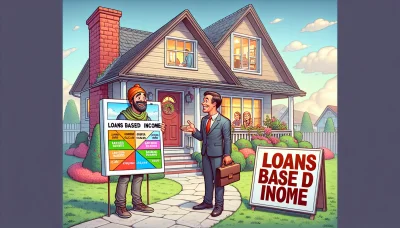Recession in real estate Quiz
Test Your Knowledge
Question of
Understanding Recession in Real Estate
Defining Economic Recession
A recession is a significant decline in economic activity that lasts for months or even years. Experts declare a recession when a nation's economy experiences negative gross domestic product (GDP), rising levels of unemployment, falling retail sales, and contracting measures of income and manufacturing for an extended period of time. It's a period that can spell trouble for industries across the board, including real estate.
Recessions are officially recognized by economists and policymakers after they occur. They assess a range of economic indicators over time to confirm that an economy has entered into a recession. The effects of a recession can be widespread, with individuals and businesses alike feeling the financial strain.
Impact on Gross Domestic Product (GDP)
GDP is the broadest indicator of a country's economy, and it represents the total market value of all goods and services produced over a specific time period. During a recession, GDP declines, signaling a reduction in economic activity. This downturn impacts consumer confidence and spending, leading to reduced demand for real estate.
As businesses earn less and lay off workers, there's less money circulating in the economy. This leads to reduced investment in property as people tighten their belts, further exacerbating the downturn in the real estate market.
Unemployment Rates During Recessions
The unemployment rate often rises during a recession as companies reduce their workforce in response to lower consumer spending and demand for services. Job insecurity and loss of income make it more difficult for people to commit to large purchases like homes, which affects the real estate market directly.
High unemployment rates can lead to an increase in foreclosures as homeowners struggle to keep up with mortgage payments. This can result in a higher inventory of homes on the market, driving down property values and making it harder for sellers to get their asking price.
The Real Estate Market Cycle
The real estate market is cyclical, characterized by periods of boom and bust. These cycles are influenced by various factors including interest rates, economic growth, and consumer confidence. Understanding where we are in this cycle can help investors, homeowners, and industry professionals make informed decisions.
- Expansion: Characterized by high demand leading to increased prices.
- Peak: The top of the cycle where growth reaches its maximum before slowing down.
- Contraction: A period when demand begins to decrease along with prices.
- Trough: The lowest point of the cycle where prices stabilize before starting to rise again.
Phases of the Real Estate Cycle
The real estate cycle consists of four main phases: recovery, expansion, hyper supply, and recession. Recognizing these phases helps stakeholders anticipate changes in pricing and demand. For example, during recovery occupancy rates begin to rise without significant new construction due to cautious investor sentiment from previous recessions.
In contrast, during expansion construction activity increases to meet high demand until eventually supply outpaces demand leading into the hyper supply phase. If not managed properly through monetary policy or other measures, this can lead into another phase of recession within the market.
Indicators of a Real Estate Downturn
Certain indicators signal an impending downturn in the real estate market. These include rising inventory levels as homes stay on the market longer than usual due to decreased buyer interest. Additionally, increasing mortgage rates can dampen buyer enthusiasm as borrowing becomes more expensive.
A shift from seller's to buyer's markets occurs when there are more properties available than there are buyers. In such scenarios, buyers have more leverage in negotiations which can result in lower selling prices for properties another sign that could indicate an approaching downturn in real estate markets.
Historical Impact of Recessions on Real Estate
Case Studies of Past Recessions
The real estate sector has often borne the brunt during economic downturns, with patterns emerging that illuminate the depth of its vulnerability. Historical case studies serve as a testament to the profound impact recessions can have on property markets. Each recession carries unique characteristics that shape real estate dynamics in distinct ways.
By examining these past events, investors and policymakers can glean insights into the triggers that precipitate declines in property values and identify factors that signal impending recovery or further deterioration. Case studies provide a rich repository of knowledge for strategizing and mitigating risks associated with real estate investments during economic turbulence.
The 2008 Financial Crisis and Housing Bubble Burst
The 2008 financial crisis, marked by the collapse of major financial institutions, triggered a catastrophic drop in real estate values globally. Predatory lending practices and an overinflated housing market led to widespread mortgage defaults, causing a ripple effect that devastated the real estate industry. The aftermath saw significant regulatory reforms aimed at stabilizing the market and preventing future crises.
Housing prices plummeted, foreclosures soared, and new construction came to a standstill. The crisis underscored the interconnectedness of financial systems and real estate markets, illustrating how vulnerabilities in one sector can rapidly spread to others. Recovery was slow, with some regions taking years to rebound as consumer confidence gradually returned.
Early 1990s Recession and Real Estate Outcomes
The recession of the early 1990s, though less dramatic than the 2008 crisis, had significant implications for real estate. Triggered by a confluence of factors including high interest rates and declining industrial production, property values experienced a notable decline. The commercial real estate market, in particular, faced a severe credit crunch as lenders tightened borrowing conditions.
However, this period also set the stage for future growth in certain segments of the market. As economies recovered, so did demand for both residential and commercial properties. This era offered valuable lessons on diversification within real estate portfolios as a buffer against localized downturns and sector-specific challenges.
Long-Term Effects on Property Values
Recessions leave an indelible mark on property values, but their long-term effects can vary widely based on regional economic resilience and policy responses. Historically, while some areas have seen prolonged depressions in property values following a recession, others have bounced back more robustly thanks to strong fundamentals such as population growth and job creation.
Understanding these long-term effects is crucial for investors who are looking to safeguard their assets against future economic downturns. It involves analyzing trends like demographic shifts, urbanization rates, and technological advancements that influence real estate demand over extended periods.
Trends in Post-Recession Recovery
- Diversification: Spreading investments across different types of properties and locations can mitigate risks.
- Government Intervention: Policies like tax incentives and interest rate adjustments play a pivotal role in stimulating recovery.
- Technological Advancements: Adoption of new technologies can enhance property management efficiency and attract tenants post-recession.
- Demographic Trends: Areas with growing populations often experience faster recovery due to increased housing demand.
- Cautious Lending: More stringent lending standards post-recession can lead to healthier market conditions over time.
Predicting Future Market Stability
Predicting future market stability is an intricate process involving economic indicators such as employment rates, inflation trends, and consumer sentiment. Experts analyze these alongside historical data to forecast potential impacts on the real estate sector. While precise predictions are challenging due to the complex interplay of global factors, careful analysis can offer valuable foresight into market trajectories.
Economic models have become more sophisticated in their ability to simulate various scenarios and gauge possible outcomes for real estate markets. Investors who stay informed about these models and regularly assess their portfolios' exposure to risk are better positioned to navigate uncertainties inherent in post-recession environments.
Identifying Signs of a Looming Recession
Key Economic Indicators to Watch
Spotting a looming recession requires vigilance, and key economic indicators provide the foresight needed. These indicators are like the pulse of the economy, signaling its health or forewarning of sickness. It's crucial to monitor metrics such as GDP growth rates, unemployment figures, and inflation rates, as they paint a clear picture of economic trends.
Apart from the general indicators, consumer spending and manufacturing data offer nuanced insights. When consumer spending decreases significantly, it can signal reduced confidence in the economy. Similarly, dips in manufacturing output might indicate a pullback in business investment, both harbingers of potential economic downturns.
Leading, Lagging, and Coincident Indicators
Leading indicators predict future economic activity and they're your crystal ball into the economy's direction. Watch out for stock market returns, the yield curve, and new business formations. A flattening yield curve or declining stock prices often precede recessions. Meanwhile, lagging indicators confirm trends after they've occurredthink of them as the hindsight mirror reflecting past economic performance.
Coincident indicators provide real-time data on the economy's current state. Sales figures and employment statistics fall into this category. They help confirm whether the economy is indeed entering a recessionary phase or if it's just experiencing a temporary hiccup.
Housing Market Specific Indicators
The housing market is often a reliable barometer for economic health. A decline in new housing starts and building permits suggests that builders are less confident about future demand. Mortgage rates and home sales volume also offer critical clues; escalating mortgage rates can dampen buyer enthusiasm, while falling sales volumes may foreshadow wider economic troubles.
Keep an eye on foreclosure rates and average time on market for listings. Rising foreclosure rates can indicate financial stress among homeowners, while longer times on market might suggest a cooling real estate landscape indicative of broader economic slowdowns.
Behavioral Signs in the Real Estate Market
The real estate market is often where early behavioral signs of a recession manifest. When sellers start slashing prices or offering incentives to attract buyers, its time to pay attention. These tactics suggest that the market is shifting from a seller's to a buyer's marketa possible precursor to an economic downturn.
Another subtle yet telling sign is when real estate agents report fewer inquiries or showings. This behavioral change indicates waning interest from potential buyers due to uncertainty or financial constraintsan early warning that could ripple through the entire economy.
Changes in Consumer Confidence
Consumer confidence is a potent indicator; when it dips, people tend to tighten their purse strings which can lead to decreased spending across various sectors. This reduction in spending can have significant knock-on effects since consumer expenditure drives much of the economy.
- Maintain Awareness: Regularly check consumer confidence indices for significant changes.
- Watch Retail: Observe retail trends as they're directly affected by shifts in consumer confidence.
- Economic News: Stay updated with economic news reports that often highlight shifts in consumer sentiment.
- Sector Sensitivity: Some sectors react more quickly to changes in confidencemonitor these closely.
- Savings Rates: An increase in savings rates may reflect consumer worries about future economic conditions.
- Luxury vs Necessity: Distinguish between spending on luxury items versus necessitiesluxury spending drops first during downturns.
Shifts in Investor Sentiment
In times of economic uncertainty, investor sentiment becomes particularly telling. A shift towards more conservative investments like bonds or gold may indicate skepticism about future growth prospects. Conversely, high levels of speculative investment could point towards unsustainable growtha red flag for an impending correction.
Paying attention to investor behavior can give you lead time before an official recession announcement hits headlines. If seasoned investors are pulling out of long-term positions or hedging their portfolios aggressively against potential downturns, take it as a signal that rougher seas may be ahead for the economy at large.
Strategies for Navigating Real Estate During a Recession
Investment Approaches in Uncertain Times
The real estate market can be unpredictable during economic downturns, and savvy investors know that adaptability is key. It's crucial to refine your investment strategies to weather the uncertainties. Focus on sectors that are less volatile and offer stable cash flows. Think residential rentals or properties in areas with strong job markets.
Investing in real estate during a recession requires a clear understanding of the market dynamics. Look out for discounted properties with potential for appreciation. However, stay cautious, as liquidity can become a challenge. Always have an exit strategy in place to avoid being caught off guard by sudden market shifts.
Diversification of Real Estate Investments
Diversifying your portfolio is essential in mitigating risks during a recession. Spread your investments across various property types and geographic locations. This approach helps cushion against market fluctuations in any single area or sector. Consider mixing commercial with residential properties, or exploring emerging markets.
Real estate investment trusts (REITs) offer an excellent vehicle for diversification. They provide exposure to a range of properties without the need for direct management. Plus, they're known for delivering consistent dividends, which is particularly appealing during economic uncertainty.
Risk Assessment and Management
Risk management becomes even more critical during recessions. You must conduct thorough due diligence on every potential investment. Analyze cash flow projections, tenant stability, and local economic indicators. Be conservative in your estimations to ensure you can withstand prolonged downturns.
Keep your leverage at manageable levels; over-leveraging can lead to financial distress if property values decline or if you face vacancies. Build a reserve fund to cover unexpected expenses or shortfalls in rental income. A proactive risk management strategy is your best defense against recession-induced challenges.
Homeownership Considerations
Buying a Home During a Recession
Purchasing a home during a recession might seem daunting, but it can present unique opportunities. Prices may be lower, giving buyers more bargaining power. Yet, it's vital to assess your job security and financial stability before making such a commitment. Ensure you're ready for long-term homeownership regardless of market conditions.
Interest rates often drop during recessions, making mortgages more affordable. Take advantage of these conditions by securing a fixed-rate mortgage to lock in low payments for the future. Remember though, recessions can affect credit availability, so maintain a strong credit score to improve your chances of loan approval.
- Research: Understand local market trends and valuations before buying.
- Long-Term Perspective: Aim for homes that meet future needs to avoid short-term reselling.
- Affordability: Stick to your budget and avoid overextending financially.
- Inspections: Invest in thorough inspections to avoid costly surprises later on.
- Negotiation: Be prepared to negotiate terms based on current market conditions.
- Economic Stability: Assess the economic health of the area where you're buying.
- Mortgage Pre-approval: Get pre-approved for a mortgage to streamline the buying process.
- Patient Approach: Don't rush into buying; take the time needed to find the right property at the right price.
Refinancing and Mortgage Strategies
In times of recession, refinancing can be an attractive option for homeowners looking to lower their monthly payments or tap into home equity. It's important to calculate potential savings against refinancing costs accurately. Refinancing makes most sense if you plan to stay in your home long enough to recoup those costs through reduced payments.
Mortgage strategies should also include consideration of adjustable-rate mortgages (ARMs). While ARMs usually offer lower initial rates compared with fixed-rate mortgages, they carry the risk of rate increases over time. If considering an ARM, ensure you understand how rate adjustments work and whether they align with your financial planning horizon.
The Role of Government and Policy During Recession
Fiscal and Monetary Policy Tools
Governments wield powerful fiscal tools to counteract economic downturns. By adjusting tax rates and public spending, they can directly influence economic activity, steering it towards recovery. These adjustments are crucial in managing the balance between stimulating growth and avoiding high inflation.
Monetary policy is equally critical during a recession. Central banks, like the Federal Reserve in the United States, manipulate money supply to maintain stability. They aim to encourage lending and investment by adjusting interest rates and reserve requirements for banks, which can have immediate effects on economic confidence.
Interest Rate Adjustments and Quantitative Easing
Lowering interest rates is a go-to strategy for central banks to spur borrowing and investing. Cheaper borrowing costs can ignite business expansion and consumer spending. However, there's a floor to how low rates can go, which sometimes leads to unconventional methods like quantitative easing buying securities to inject money directly into the economy.
Quantitative easing increases the money supply, aiming to lower long-term interest rates further when short-term rates are already at rock-bottom. This encourages more risk-taking in financial markets, ideally translating into broader economic activity. But beware these measures can inflate asset bubbles if not carefully managed.
Government Stimulus Measures and Bailouts
When demand plummets, governments often step in with stimulus measures. These can include infrastructure projects that create jobs or direct payments to citizens to boost consumption. It's a jolt of energy for the economy that can kick-start growth.
- Targeted Relief: Aid directed towards industries or demographics hit hardest by the recession.
- Time-bound Initiatives: Temporary measures designed to provide immediate relief without long-term fiscal burdens.
- Conditional Bailouts: Support for struggling businesses with stipulations aimed at ensuring future fiscal responsibility.
- Balanced Approach: A mix of spending cuts and revenue increases to prevent ballooning deficits.
- Evidence-based Allocation: Funding programs with proven effectiveness in stimulating economic recovery.
Housing Market Regulations and Interventions
The housing market often feels the brunt of a recession, leading governments to enact regulations aimed at stabilizing it. Such interventions can prevent a cascade of foreclosures that would further damage the economy. Regulatory oversight ensures lending practices don't become too risky.
Foreclosure Prevention Programs
Foreclosure prevention programs are a lifeline for homeowners struggling during recessions. By offering mortgage modifications or temporary relief, these initiatives help individuals keep their homes while also supporting broader housing market stability.
Affordable Housing Initiatives
Affordable housing initiatives gain traction during recessions as governments strive to support those most affected by economic hardship. Subsidies or zoning law adjustments can encourage the development of affordable units, contributing both to social welfare and job creation.
Preparing for Post-Recession Real Estate Opportunities
Forecasting the Market's Direction
The art of forecasting real estate market trends can be a powerhouse move for savvy investors. By keeping a close eye on economic indicators and interest rates, you can anticipate property values and rental demand fluctuations. It's not just crystal ball gazing; it's informed prediction-making that could pay dividends!
Understanding the cyclical nature of real estate is crucial. Historically, markets have shown patterns of recovery post-recession, which can lead to significant investment opportunities. Recognize these cycles, and you'll be equipped to make moves that others might miss!
Analyzing Supply and Demand Dynamics
Supply and demand are the heartbeat of the real estate market. A low housing supply with soaring demand typically means prices are risinggreat if you're selling, challenging if you're buying. Keep your finger on this pulse to know when to make your move!
Demographic shifts play a pivotal role in shaping supply and demand. For instance, an influx of young professionals to a city can ignite demand for rental properties. Spot these trends early, and you could unlock the door to lucrative investment opportunities.
Identifying Emerging Market Trends
Dive into local insights! Emerging neighborhoods or sectors can present golden opportunities for investors who spot them first. Whether it's a new tech hub or a neighborhood cultural renaissance, being ahead of the curve can lead to impressive returns.
Technology advancements also influence real estate trends. From virtual home tours to blockchain in property transactions, staying tech-savvy can give you a competitive edge in identifying innovative market opportunities.
Building Resilience in Real Estate Portfolios
A resilient portfolio is your shield against market volatility. Diversification is keyspread your investments across different property types and geographic areas to mitigate risks associated with any single market.
Liquidity should not be overlooked! Ensure some of your assets are easily convertible to cash for those times when opportunities arise quickly or when the market takes an unexpected turn.
Stress Testing Investment Portfolios
- Evaluate potential impacts: Regularly assess how hypothetical scenarios like interest rate hikes or economic downturns could affect your investments.
- Diversify assets: Spread your investments across various markets and sectors to reduce risk exposure.
- Maintain liquidity: Keep a portion of your portfolio liquid to cover obligations without incurring losses from premature asset sales.
- Review leverage levels: High leverage amplifies risks during downturns; ensure your borrowing strategy aligns with your risk tolerance.
- Monitor cash flow: Positive cash flow properties can provide stability during market turbulence, so prioritize investments with reliable income streams.
- Stay informed: Continuous education about market changes enables proactive portfolio adjustments rather than reactive responses.
- Consult experts: Professional insights can guide stress testing methodologies and reveal blind spots in your strategy.
Establishing a Contingency Plan
A contingency plan is like a life jacket for your investmentsit keeps you afloat during storms. This plan should detail strategies for managing sudden economic shifts or property devaluationsalways prepare for choppy waters!
Your contingency plan must include clear action steps for worst-case scenarios. Whether it's securing alternative financing options or having an exit strategy for underperforming assets, preparation is paramount to navigating uncertainties successfully.












